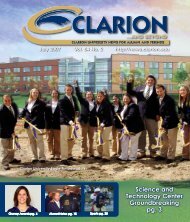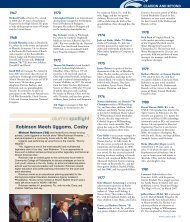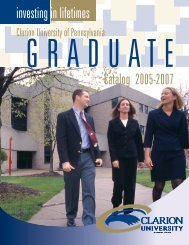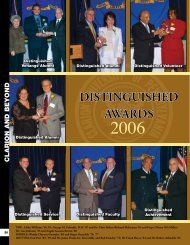Graduate - Clarion University
Graduate - Clarion University
Graduate - Clarion University
- No tags were found...
You also want an ePaper? Increase the reach of your titles
YUMPU automatically turns print PDFs into web optimized ePapers that Google loves.
<strong>Clarion</strong> <strong>University</strong> of Pennsylvania 23A maximum of six credits from the 400-level courses listed below can be taken for graduate credit with permission from the graduateprogram coordinator or department chair. 400-level courses taken for undergraduate credit cannot be repeated for graduate credit.Biology Courses410: Field Methods in Environmental Biology 3 s.h.A field-based course designed to give students hands-on experience in the various methods needed in environmental studies.The course will focus on the environmental assessment of terrestrial and aquatic habitats and the impacts of perturbationson flora, fauna, and natural landscapes. Prerequisites: BIOL 155/156: Principles of Biology II and laboratory, BIOL 202:Principles of Ecology, or permission of instructor. Summers, on demand.BIOL 460: Comparative Vertebrate Anatomy 3 s.h.Traces the most important trends in the evolution of basic structures in vertebrate lines and conveys an appreciation of howthe mammals came to possess the combination of characters that make this group unique. Two lecture and three laboratory hoursweekly. Prerequisites: Completion of two semesters of introductory biology or permission of instructor. Alternate years.BIOL 464: Developmental Biology 3 s.h.Study of the major processes in development and their underlying mechanisms. Includes descriptive study and mechanismssuch as differentiation, induction, and morphogenesis. Deals primarily with animal development. Two lecture and threelaboratory hours weekly. Prerequisites: Completion of two semesters of introductory biology, genetics, and two semesters ofgeneral chemistry or permission of instructor. Annually.BIOL 470: Mammalology 3 s.h.Interrelationships of mammals and the biotic and abiotic environment. Includes discussions and investigations of mammaliandistribution, diversity, taxonomy, ecology, and physiology. Includes both field and laboratory studies. Two lecture and threelaboratory hours weekly. Prerequisite: A course in ecology or permission of instructor. On demand.BIOL 471: Plant Ecology 3 s.h.In-depth approach to the interaction of plants with the physical and biotic environments at population, community, ecosystem,and landscape scales. Lecture and discussion focus on current topics in plant ecology such as disturbance, succession, herbivory,dispersal, competition, and environmental stress. Laboratory includes field-based experimental and descriptive investigationsof plant population and communities. Two hours lecture/discussion and three laboratory hours weekly. Prerequisite: A coursein principles of ecology or permission of instructor. On demand. (Pymatuning)BIOL 500: <strong>Graduate</strong> Seminar 1-2 s.h.A survey of current literature, concepts, and theories from selected fields of biology. Two discussion hours weekly. Byarrangement.BIOL 502: Biometry 3 s.h.Collection, analysis, and presentation of biological data. Fundamental aspects of designing and executing descriptive andexperimental studies with emphasis on biological research. Applications to undergraduate and graduate research in progressin the Department of Biology are stressed. Three lecture hours per week. Spring, alternate years.BIOL 503: Special Topics in Biology 1-4 s.h.Semi-independent studies of topical material under the guidance of the instructor. Maximum credit allowable towardgraduation: nine semester hours. Prerequisites: permission of instructor and the student’s graduate committee.BIOL 504: Computational Molecular Biology and Bioinformatics 3 s.h.The new disciplines of genomics, proteomics, and bioinformatics attempt to analyze and make sense of the data generatedby the Human Genome Project and other genome projects. This course is an introduction to the computational techniques andalgorithms which are used. Topics will include data base searches, pair-wise and multiple alignments, similarity searching,protein structure, gene mapping and genomic maps and simulation. This interdisciplinary course will be of interest to studentsin biology, molecular biology, ecology, evolutionary biology, biochemistry, industrial mathematics, and computational science.Prerequisite: BIOL 201 Genetics and MATH 260 Applied Calculus or MATH 221 Elementary Applied Statistics, or permission ofinstructor. No programming experience is necessary, but a facility with computers is assumed. Pre-session, alternate years.BIOL 505: Ecological Applications 3 s.h.A case history approach to the analysis and possible resolution of both terrestrial and aquatic environmental problems.Students will analyze the problem from a number of perspectives, including the biological, in an assessment of the problem.Sample design, cost considerations, data collection, and analysis will be incorporated into the assessment. The overall assessmentof the problem and possible resolution will be conveyed both orally and in a written format. This course is considered a capstonefor students in the Applied Ecology Program, but is appropriate for other students who meet the prerequisites. Prerequisites:BIOL 202, or permission of the instructor. BIOL 493 and 494 are recommended. Spring, alternate years.BIOL 508: Biology Internship 1-3 s.h.Internships provide practical experiences that are related to a student’s academic program or research area. Credits earnedcan be utilized as partial fulfillment of the Master of Science degree in biology. Students considering internship credits to beapplied toward the Master of Science degree must have the approval of their graduate advisory committee, the cooperatingagency, and the appropriate university administrators. On demand.BIOL 511: Wildlife Ecology and Management 3 s.h.A study of the ecology and management of mammals, birds, amphibians, and reptiles. Lectures cover population dynamics,estimation, and population viability, sampling techniques, habitats, disease, and both game and non-game management. Labsemphasize wildlife population modeling, habitat assessment using GIS, and evaluation of alternative management strategies.Students will develop their own wildlife management plans. Two hours of lecture and three hours of laboratory weekly.Prerequisite: BIOL 202 or permission of instructor. Fall, alternate years.Biology
















